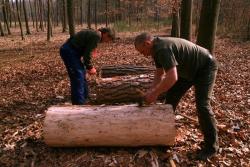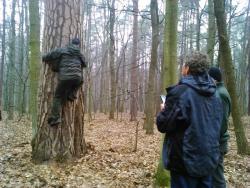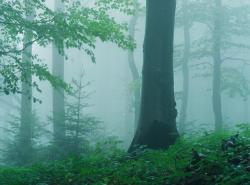 Asset Publisher
Asset Publisher
The State Forests National Forest Holding
The State Forests National Forest Holding is the largest organisation in the European Union managing forests, which belong to the State Treasury and celebrating its 90 anniversary this year.
Presently, we manage the area of one third of Poland's territory. Not long after the end of the Second World War, there was only 21 % of the area. Every year we plant 500 million of new trees, as we want Polish forests grow all the time.
Every year Polish foresters plant 500 million of trees.
85 % of nature reserves in Poland are located within the State Forests. 40 % of the forests managed by General Directorate of the State Forests are protected within the framework of European network Natura 2000. We fight against many threats: natural disasters, plaques of insects, trees' diseases, fires, pollutions, as well as poaching and vandalism.
We take care the forestry supplying the market with timber, as ecological and universal material, to be carried on in accordance with rules of balanced development (photography P.Fabjański).
One of our major tasks is making forests accessible to the society. We invite you to take advantage of these beautifully located within the forest wilderness holiday resorts, forester's lodges or guest rooms. That is for you, we create thousand kilometres of hiking trails, cycling paths or camping sites. All the above mentioned, you can find in service www.czaswlas.pl.
We also take care the forestry supplying the market with timber, as ecological and universal material, to be carried on in accordance with rules of balanced development. We obtain over 30 million of cubic meters of wood annually, twice as much as at the beginning of the nineties of the XX century.
Despite of this, the average of wood abundance per hectare of our forests is one fourth bigger than 20 years ago and 40% bigger than the average of European Union currently amounts.
In Poland in sectors connected with the forestry, there work about 375 thousand of people. It means that each 40 working Pole works in the forest.
In Poland in sectors connected with the forestry, there work about 375 thousand of people. It means that each 40 working Pole works in the forest. The sector of wood processing works out approximately 8 % of our GDP (Gross Domestic Product). Among others, thanks to the timber from the State Forests Poland is the 10 largest producer of furniture in the world, and the 4 largest furniture exporter.
The State Forests employ 25 thousand people. That way we are the 9 biggest employer in Poland. Among the largest companies in our country it takes 22 place in respect of its incomes and 11 place in respect of its profits. The value of assets, we manage, reaches 300 million zl. If we add social values, it will be worth one billion zlotych. We do not use money from the budget, but we earn money on our own to support the business. In spite of the financial crisis, since 2002, we continuously note down profits. Moreover, we pay taxes amounting 1,3 billion zl annually.
87 % of Poles think, the foresters are competent. We willingly share our knowledge of Polish forests, of their history and of nature values with the others. We publish books, periodicals, brochures; we also administer the website www.lasy.gov.pl . For children, the youth and teachers, we prepared internet service "E-lynx' Lynx Forest" (www.erys.pl). Our staff has supported schools in field of nature education for years. We also organise many actions to let people broaden their knowledge about forest, nature and ecology.
 Asset Publisher
Asset Publisher
 Asset Publisher
Asset Publisher
Warsztaty bartnicze
Warsztaty bartnicze
 foto. Archiwum N-ctwa
foto. Archiwum N-ctwa
 foto. Archiwum N-ctwa
foto. Archiwum N-ctwa
 foto. Archiwum N-ctwa
foto. Archiwum N-ctwa
 fofo.Archiwum N-ctwa
fofo.Archiwum N-ctwa
 foto. Archiwum N-ctwa
foto. Archiwum N-ctwa
 foto. Archiwum N-ctwa
foto. Archiwum N-ctwa
 foto. Archiwum N-ctwa
foto. Archiwum N-ctwa
 foto. Archiwum N-ctwa
foto. Archiwum N-ctwa
 foto. Archiwum N-ctwa
foto. Archiwum N-ctwa
 foto. Archiwum N-ctwa
foto. Archiwum N-ctwa
"Bartnictwo jest niezwykle pożądane w lasach – zwiększa liczbę zapylaczy roślin leśnych, przyczynia się do ochrony starych najcenniejszych lasów, może stanowić produkt regionalny dla lokalnej społeczności, a także być atrakcją ściągająca rzesze turystów…"
Tradycje bartne związane z dzikimi pszczołami zaniknęły w Polsce w XVIII wieku i na początku XIX wieku nie tylko z powodu rozwoju rolnictwa, przemysłu ale i nowych jak na tamte czasy metod hodowlanych. Tradycje bartne przetrwały natomiast do dziś na południowym Uralu, w Republice Baszkortostan w Rosji. Miód produkowany przez dzikie pszczoły jest tam towarem bardzo poszukiwanym na całym świecie.
Początek tej historii zaczyna się w roku 2006, kiedy to na zaproszenie Spalskiego Parku Krajobrazowego do Polski przyjechało dwóch bartników z Baszkirii (azjatycka część Rosji), którzy w kilku wiekowych sosnach w lasach spalskich wydrążyli barcie i nauczyli zapomnianego fachu Polaków. Wśród nich był leśniczy Andrzej Pazura.
Obecnie odtworzenie bartnictwa budzi duże zainteresowanie wśród leśników na terenie całego kraju, dlatego też w dniu 27 marca bieżącego roku w Nadleśnictwie Spała zorganizowano pierwsze warsztaty bartnicze. Pod okiem doświadczonego bartnika Pana Andrzeja Pazury – leśniczego leśnictwa Jasień, uczestnicy warsztatów z nadleśnictw: Płytnica i Katowice nabywali wiedzę zarówno teoretyczną, jak i praktyczną z tego zakresu.
Na wyrzynkach, przygotowanych ze starej spalskiej sosny, uczestnicy uczyli się krok po kroku dziania kłody bartnej. Mieli również możliwość wykonania barci w stojącej sośnie przeznaczonej do zasiedlenia przez pszczołę leśną. Pan Andrzej – prawdziwy pasjonat pszczelarstwa uatrakcyjniał zajęcia ciekawostkami na temat technik pozyskiwania miodu i wosku. Po zakończeniu zajęć uczestnicy otrzymali wykonane przez siebie kłody bartne, które będą mogli zaprezentować współpracownikom, przekazując przy tym wiedzę zdobytą podczas zajęć, między innymi to, że barcie wydrążane są w żywym drzewie, zaś kłody bartne, to wieszane na drzewach kawałki drewna, przeważnie o długości 1,5-2 m, przygotowywane specjalnie dla pszczół.
Akcentem kończącym warsztaty było pokazanie uczestnikom najciekawszych miejsc Spały, m.in. Groty Św. Huberta, Kościoła pw. Matki Bożej Królowej Korony Polski, pomnika Żubra, a także zapalenie symbolicznego znicza pod pomnikiem Leśnika przy Domu Pamięci Walki i Męczeństwa Leśników i Drzewiarzy Polskich im. Adama Loreta.


 fot. Paweł Fabijański
fot. Paweł Fabijański
 fot. Paweł Fabijański
fot. Paweł Fabijański
 fot. Paweł Fabijański
fot. Paweł Fabijański




